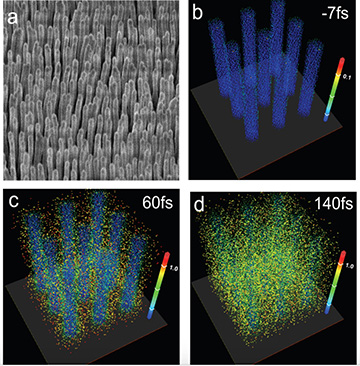Scanning electron micrograph (a) of deuterated-polyethylene nanowires used in experiments, and numerical simulations (b-d) of those nanowires exploding under the influence of ultra-intense laser pulse. [Image: Advanced Beam Laboratory/CSU] [Enlarge image]
The words “laser fusion” conjure up vast, megajoule laser installations housed in football-field-sized buildings, such as the U.S. National Ignition Facility (see “Laser fusion: The uncertain road to ignition,” OPN, September 2014). But researchers from the United States and Germany, led by OSA Fellow Jorge Rocca of Colorado State University, recently managed to churn out micro-scale fusion reactions using much more modest equipment. Their setup: a 1-J, tabletop femtosecond laser built from scratch—with a dense array of polyethylene nanowires serving as the fusion target (Nat. Commun., doi: 10.1038/s41467-018-03445-z).
The team believes that its recipe could offer a good source of pulses of bright, near-monoenergetic neutrons for some imaging and materials-science applications. And the ability to create extreme plasmas with a compact laser, the researchers suggest, could open interesting windows into high-energy-density science.
Nanowire forest
The research team (including scientists from Colorado State University and the Nevada National Security Site, USA, and the Institut für Theoretische Physik, Germany) began its setup by creating 12.5-mm diameter arrays of vertical, 200-nm- and 400-nm-diameter and 5-micron-long nanowires as fusion targets. The wires were made of deuterated polyethylene (CD2), a polymer in which deuterium (so-called heavy hydrogen), with a nucleus including one proton and one neutron, substitutes for ordinary hydrogen, which includes one proton only.
The researchers arrayed the vertical nanowires on a 200-micron-thick substrate of solid CD2, packing in the wires with sufficient interstitial space to make the array’s density 16 to 19 percent of the density of the solid polymer. That created a “near-solid-density” medium to serve as the target.
Next, the scientists used a frequency-doubled, 400-nm chirped-pulse amplification Ti:sapphire laser to generate 60-fs laser pulses with total energies of around 1.65 J, and aimed that stream of pulses at the nanowire-forest samples. They focused the pulses into a spot 2 to 2.6 microns in diameter, thereby creating intensities on the order of 1020 W/cm2 on the target.
From plasma to fusion
According to the researchers, the vacant spaces around the nanowires let the energy from the relativistic-intensity laser pulses penetrate deep inside the nanowire structure, where it becomes trapped and “practically totally absorbed.” The absorbed energy rips electrons off of the nanowire surface and accelerates them to high velocities, at which they interact with the nanowires and cause them to explode into a void-filling plasma. Within that plasma, the electron-stripped deuterium nuclei, or deuterons, achieve kinetic energies on the order of 3 MeV. Those energies drive deuteron-deuteron fusion reactions that create streams of neutrons, with a characteristic energy of 2.45 MeV, as by-products.
In experiments with the nanowire targets, the team found that it could produce fluxes of 2.45-MeV, fusion-generated neutrons some 500 times larger than experiments using flat, solid CD2 targets. The team claims that the observed 2 × 106 neutrons per joule is “the largest D–D fusion neutron yield reported to date for plasmas generated by laser pulse energies in the 1 J range.” And numerical simulations suggest that relatively small increases in laser pulse energy could significantly increase the fusion neutron yield.
The repetition-rate advantage
A particular strength of the setup, according to the researchers, is the compact laser’s ability to pump out femtosecond pulses at a high repetition rate, compared with the Hz-scale or slower rates of petawatt-class lasers. The creation of a target that can achieve fusion with these lower-energy, high-repetition-rate lasers, the researchers suggest, is “of significant interest” for high-energy-density science, such as studies of conditions in the cores of stars.
On a more applied note, the team suggests that its approach using nanowire arrays could allow the creation of efficient point sources of quasi-monoenergetic neutrons for neutron imaging and tomography, neutron diffraction studies in materials science, and other uses.


